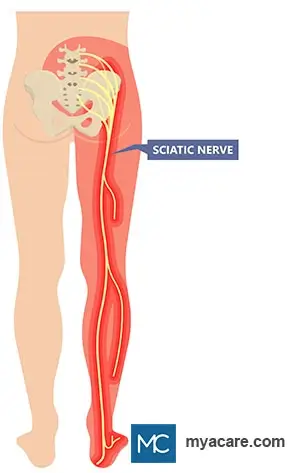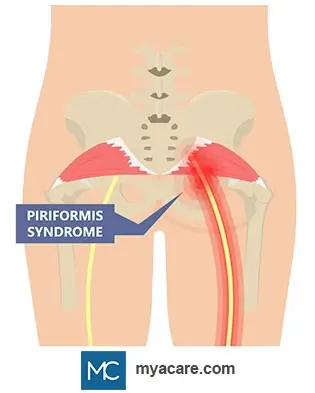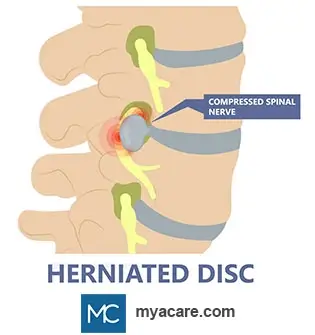Piriformis Syndrome & Herniated Disc: Similarities and Differences

Originally Authored by Shailesh Sharma - September 17, 2019
Medically Reviewed and Updated by Dr. Sony Sherpa, (MBBS) - July 26, 2024
Piriformis syndrome and herniated discs are painful conditions of the back. Both can cause sciatica. Sciatica is a type of pain that affects your lower back and legs. It occurs due to irritated or compressed sciatic nerve. The sciatic nerve travels down the back to the legs.

Piriformis syndrome is often misdiagnosed as a herniated disc and vice-versa.
Here, we explore the similarities and differences between piriformis syndrome and herniated disc.
What is Piriformis Syndrome and What are Its Symptoms?
Piriformis syndrome causes pain in the hip, buttock, groin, and leg. It occurs when the sciatic nerve next to piriformis muscle is irritated or pinched.

The piriformis muscle and sciatic nerve are close to each other. Thus, any irritation or swelling in the muscle can compress the sciatic nerve.
Estimates suggest that nearly 6 percent of patients with sciatica have piriformis syndrome.
Piriformis Syndrome is sometimes associated with Deep Gluteal Syndrome, a condition characterized by pain and/or dysesthesia (abnormal sensation) in the buttock, hip, or posterior thigh due to non-discogenic and extrapelvic entrapment of the sciatic nerve in the deep gluteal space.
Apart from sciatica, piriformis syndrome can cause:
- Long-term pain in the buttock and hip that may radiate to the leg
- The pain usually becomes worse with activity
- Numbness and tingling sensations in the buttock
- Problems with sitting for a prolonged time
What is a Herniated disc and What are Its Symptoms?
A herniated disc refers to a condition in which one or more spinal discs are displaced from the space between two bones in the vertebrae. It is also known as a slipped disc.
Spinal discs are small rubbery pads situated between the bones that make your spine. They provide cushioning for these bones. The discs contain soft materials enclosed in a tough fibrous covering.

Increasing age and injuries can weaken or destroy the covering. In some people, the soft materials inside the discs push through weaker parts in the covering. This is known as a herniated disc or disc herniation.
The soft materials that come out of the covering can press or irritate the sciatic nerve. This causes sciatica.
Herniated discs affect people of all ages, but most commonly between the ages of 30 and 50. The symptoms vary depending on the location of the herniation.
What does a herniated disc feel like?
Disc herniation in the lower back can cause:
- Back pain that spreads to the thigh and sometimes the lower leg
- Pain in the buttock
- Numbness or Tinging
- Muscle Weakness
Piriformis Syndrome and Herniated disc: What are the Similarities?
The most important similarity between piriformis syndrome and a herniated disc is that both can cause sciatica.
The other similarities include:
- Pain that occurs when you move or continue a standing or seating position for a prolonged time
- Most often, the pain becomes worse with activities like getting out of bed
- Numbness or tingling sensations in the buttocks and legs
- A weakness of the legs in severe cases
- Temporary relief of pain while lying on the side or in a fetal position
Piriformis Syndrome and Herniated disc: What are the Differences?
Many symptoms of piriformis syndrome and herniated disc are similar. For a patient, it can be extremely difficult to distinguish one condition from another.
The same problem may occur with clinicians too. This is the reason why these two conditions are often misdiagnosed.
Below is a list of key differences between piriformis syndrome and herniated disc.
- Location of the pain. Piriformis muscle is located in the buttock. Thus, pain in piriformis syndrome begins in the buttock.
However, disc herniation can occur in any part of the spine. For this reason, pain due to disc herniation can occur in the regions other than the lower back. For example, the shoulder and arm.
- Occurrence. Herniated disc affects 5 to 20 out of every 1000 adults. On the other hand, piriformis syndrome affects 5 to 36 out of every 100 persons with low back pain. From this data, we may say that piriformis syndrome is more common than disc herniation.
- Gender differences. Piriformis syndrome is more common in women. Studies show that the female-to-male ratio for its occurrence is 6:1.
A herniated disc is more common in men. Estimates suggest that the male-to-female occurrence ratio is 2:1.
- Risk of recurrence. Both piriformis syndrome and herniated disc can return after successful treatment. However, the rates of recurrences are different.
With treatments combining medications with rehabilitation exercises, piriformis syndrome rarely comes back.
On the other hand, recurrent herniated discs (after surgery) are more common affecting 1 to 21 out of every 100 patients.
- Treatment
Treatment for Piriformis Syndrome primarily aims at muscle relaxation and increasing flexibility, while treatment for a Herniated Disc focuses on reducing inflammation and relieving nerve pressure.
Surgical Procedures for Piriformis Syndrome
- Piriformis Muscle Release: This involves cutting or releasing the piriformis muscle to relieve the pressure on the sciatic nerve. When performed with the help of an endoscope it is known as Endoscopic Piriformis Release.
- Sciatic Nerve Neurolysis: This involves the surgical removal of scar tissue or adhesions that may be compressing the sciatic nerve.
- Botulinum Toxin (Botox) Injection: Although not a surgical procedure, they can be used to paralyze the piriformis muscle temporarily, providing relief from nerve compression.
Surgical Procedures for Herniated Disc
- Microdiscectomy: This minimally invasive procedure removes a small amount of bone or disc material to ease pressure on a pinched nerve and allow it to heal properly.
- Endoscopic Discectomy: In this procedure, an endoscope is used to remove the herniated disc material causing nerve compression.
- Laminectomy: This surgery involves removing the lamina. It is often performed when spinal stenosis causes the compression of the nerve roots.
- Artificial Disc Replacement: This procedure involves replacing the damaged disc with an artificial one.
- Percutaneous Discectomy: This involves using a needle to remove the damaged portion of the disc through the skin.
The Bottom Line
Piriformis syndrome and herniated disc can cause pain in the lower back. It is often difficult to distinguish one condition from another. This is because most symptoms are common to both the conditions.
Besides, treatments may also be similar for less severe cases. Surgery is the last resort of treatment. Patients who do not get better with conservative treatments may need surgery. Conservative treatments involve the use of pain medications and physical therapy.
However, the type of surgery may be different for piriformis syndrome and disc herniation.
There are some major differences between the two conditions. They are the rates of occurrence and relapse, the location of the pain, and gender differences.
Differentiating these two conditions may require specific diagnostic tools. For example, an ultrasound scan, MRI, CT, or EMG.
To search for the best Neurosurgery Healthcare Providers in Croatia, Germany, India, Malaysia, Spain, Turkey, the UAE, the UK and The USA, please use the Mya Care Search engine
To search for the best healthcare providers worldwide, please use the Mya Care search engine.
The Mya Care Editorial Team comprises medical doctors and qualified professionals with a background in healthcare, dedicated to delivering trustworthy, evidence-based health content.
Our team draws on authoritative sources, including systematic reviews published in top-tier medical journals, the latest academic and professional books by renowned experts, and official guidelines from authoritative global health organizations. This rigorous process ensures every article reflects current medical standards and is regularly updated to include the latest healthcare insights.

Dr. Sony Sherpa completed her MBBS at Guangzhou Medical University, China. She is a resident doctor, researcher, and medical writer who believes in the importance of accessible, quality healthcare for everyone. Her work in the healthcare field is focused on improving the well-being of individuals and communities, ensuring they receive the necessary care and support for a healthy and fulfilling life.
Sources:
Featured Blogs



